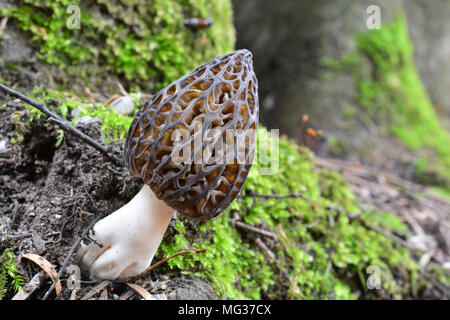The Morel Mushroom (Morchella spp.) is one of the most prized fungi among foragers and chefs alike. Known for their distinctive honeycomb-like caps and rich, nutty flavor, these mushrooms are both a culinary delicacy and a source of health benefits. With numerous species, including the Yellow Morel and Black Morel, these mushrooms are a springtime treasure. In this article, we will explore the most popular types of Morel mushrooms, their health benefits, and tips on how to use them safely.
The Most Popular Types of Morel Mushrooms
-
Yellow Morel (Morchella esculenta)
The most widely recognized and sought-after variety.
Found in deciduous forests, often near elms, oaks, and ash trees.

Black Morel (Morchella elata)
Distinguished by its darker, ridged cap.
Common in areas affected by forest fires or logging.

Half-Free Morel (Morchella punctipes)
Features a cap that is partially attached to the stem.
Smaller in size but still a favorite among foragers.

Burn-Site Morel
Grows in areas affected by recent wildfires.
Known for appearing in large quantities in disturbed soil.

Health Benefits of Morel Mushrooms
-
Rich in Nutrients
High in vitamins such as D and B-complex.
Contains essential minerals like copper and potassium.
Boosts Immunity
Contains antioxidants that support the immune system.
Supports Bone Health
The high vitamin D content aids in calcium absorption.
Improves Digestion
Contains dietary fiber that promotes gut health.
Promotes Healthy Skin
Rich in antioxidants that combat free radicals and improve skin health.
Aids in Weight Management
Low in calories but high in protein and fiber.
Anti-Inflammatory Properties
Helps reduce inflammation in the body.
Supports Heart Health
Contains compounds that may help lower cholesterol levels.
Energy Boosting
The B vitamins improve energy metabolism.
May Have Anticancer Properties
Preliminary studies suggest compounds in morels may inhibit tumor growth.
Safe Usage of Morel Mushrooms
-
Cooking is Essential
Never eat morels raw as they contain hydrazine toxins that are neutralized by cooking.
Sautéing, frying, or simmering for at least 15 minutes ensures safety.
Proper Cleaning
Gently brush off dirt or rinse quickly under cold water.
Avoid soaking for long periods, as they are porous and can absorb too much water.
Identification Matters
Be cautious of false morels (Gyromitra spp.), which can be toxic.
True morels have hollow stems, while false morels do not.
Moderation is Key
Even when cooked, consuming large quantities can cause digestive upset.
Storage
Fresh morels should be refrigerated and consumed within a few days.
They can also be dried or frozen for long-term storage.
Allergy Precautions
Introduce morels gradually into your diet to check for potential allergies.
Morel mushrooms are not only a gourmet treat but also a powerhouse of nutrients and health benefits. Whether you are foraging in the wild or buying them from a trusted source, proper identification, cleaning, and cooking are crucial to enjoy them safely. With their rich flavor and versatility in cooking, Morels are truly a treasure worth savoring. We are no experts and do not take responsibility for any issues that may arise; this article is for informational purposes only. Always consult with an expert or reliable guide when foraging for these prized fungi to ensure your safety.
News
JJ Redick reacts to Luka Doncic trade for Anthony Davis
In one of the most jaw-dropping moves of the season, the NBA landscape was rocked by the blockbuster trade involving Luka Dončić and Anthony Davis—a swap that has sent ripples of excitement, disbelief, and heated discussion through the league. Among…
Anthony Davis FULL reaction to trade to Mavericks for Luka Doncic
In a blockbuster move that sent shockwaves through the NBA and left fans reeling, Anthony Davis has been traded to the Dallas Mavericks in exchange for Luka Dončić. In the immediate aftermath of the news, Davis took to the media…
Shaq reacts to Dallas Mavericks wanting Kevin Durant after Luka-AD trade 
In the constantly shifting world of the NBA, trade rumors and blockbuster moves are a regular part of the season’s drama. The latest twist has fans buzzing: the Dallas Mavericks have reportedly set their sights on acquiring Kevin Durant in…
Donovan Mitchell FILTHY poster dunk on Kristaps Porzingis 
In a game filled with high-intensity moments and jaw-dropping highlights, one play in particular has left fans and analysts buzzing about Donovan Mitchell’s latest display of athleticism. Early in the contest, with the atmosphere already charged by an evenly matched…
Joel Embiid hits go-ahead bucket vs Mavs then chats with Anthony Davis after game
In one of the most thrilling contests of the season, Joel Embiid delivered a clutch performance against the Dallas Mavericks, punctuating the game with a go-ahead bucket that sent the home crowd into a frenzy. The atmosphere in the arena…
D’Angelo Russell game winner as Nets hit two 3’s in 3 seconds to win vs Rockets 
In one of the most electrifying moments in recent NBA history, D’Angelo Russell delivered an unforgettable game-winner that left fans and commentators in complete awe. With the Brooklyn Nets locked in a tense battle against the Houston Rockets, the outcome…
End of content
No more pages to load











